For this week’s Sunday Visit interview series, we are excited to feature Kalen Kaminski, the creative force behind Upstate, a vibrant New York-based studio renowned for its handcrafted textiles, apparel, and glassware. With a background in set design and prop styling, Kalen has cultivated a unique aesthetic that blends whimsy with sustainability. Inspired by nature and global travels, she crafts one-of-a-kind pieces that reflect her passion for color and experimentation. From her early days as a prop stylist to founding Upstate, Kalen’s journey is a testament to innovation and collaboration, as she continues to push boundaries in design while advocating for environmental responsibility. Join us as we delve into her artistic process, her commitment to sustainability, and the inspiring story behind Upstate.
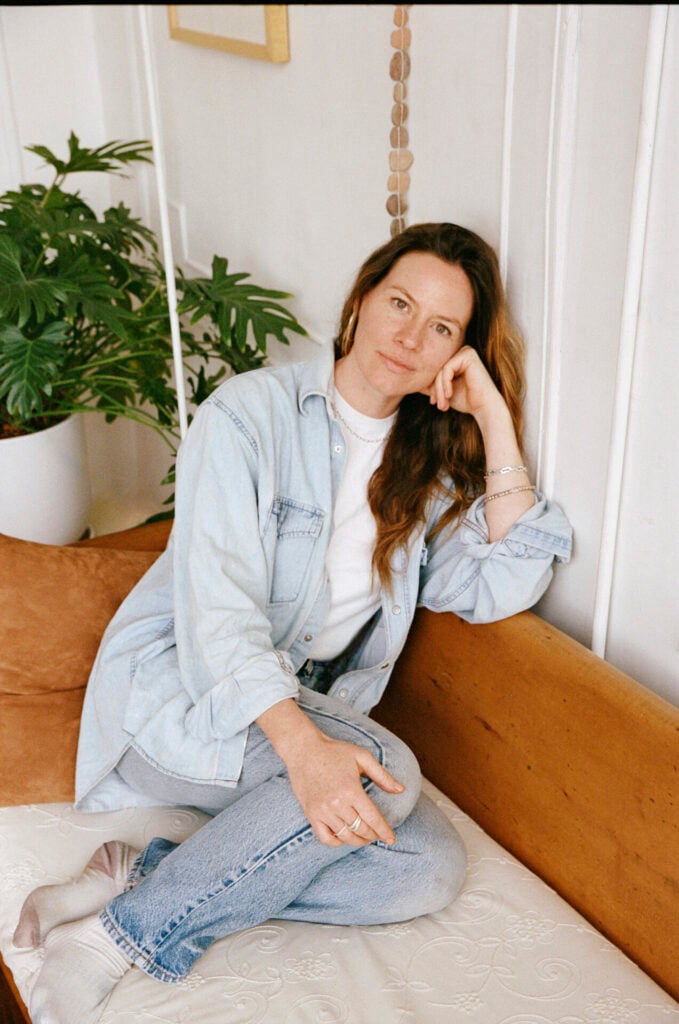
Roots and Beginnings: What are some of the earliest memories or experiences that seeded your love for natural dyes and craftsmanship? How do these roots continue to nourish your creative journey?
My mom is the best cook I know! And I connect this love of food and cooking to dyeing. Her ideal day is and was spent in the garden, weeding, growing and gathering fresh produce to use in her cooking. I grew up spending time with her in the garden, learning about herbs and different vegetables and even helping with more obscure projects like harvesting her fennel pollen. Grocery shopping would take us hours because she would carefully read every ingredient of everything we put in our cart, which felt very uncommon and embarrassing back then! I used to roll my eyes at this, but now I’m doing the same thing! Although I didn’t learn about natural dyes until my twenties, watching her cook and transform fresh ingredients into delicious, beautiful meals felt like alchemy. I see a parallel between this process and the artisanal craft world, especially dyeing.
Your work with Upstate involves hand-dyeing textiles. Could you walk us through your process for creating natural dyes and how you select materials for your color palette?
This is a great question, and it’s constantly changing! It depends on whether I’m prepping for a workshop, working on a production, or just experimenting. I always love to see what’s new at Botanical Colors, and I’m a big fan of Mordant Mondays! Installing a stove in my studio a few years ago also helped me prep a wide variety at once; however, lately, I’ve been enjoying the color that comes from not heating the dyes and allowing fabrics to marinate in the colors for multiple days with the heat from the sun. It also depends on the time of year. For example, in the fall, my friend Casey Havre, formerly of Lagier Ranches in Northern California, has been sending me almond hulls from her harvest, I’ll store them in my freezer year round and when I can simmer them over time (for days) in my studio, it gives the most vibrant and rich tan with a slight blush tone. It’s also loaded with tannins, so I haven’t had to mordant the fabric. Additionally, it gives off the sweetest, nuttiest smell. When I’m traveling, I’ll sneak some leaves and twigs into my bag from various plants just to test the color. Last year, I brought back some loquat leaves from Sicily, which also gave the loveliest blush tone when I worked with them on low heat. My friend in Colorado has sent me hollyhock flowers from her garden, which produce a nice lavender color. I’m constantly pivoting and changing my practice, even though I love the idea of routine, so there is never just one way I’m creating the color, and I’m always discovering new methods. Realizing I may not be answering your question but you get the idea ahah 🙂
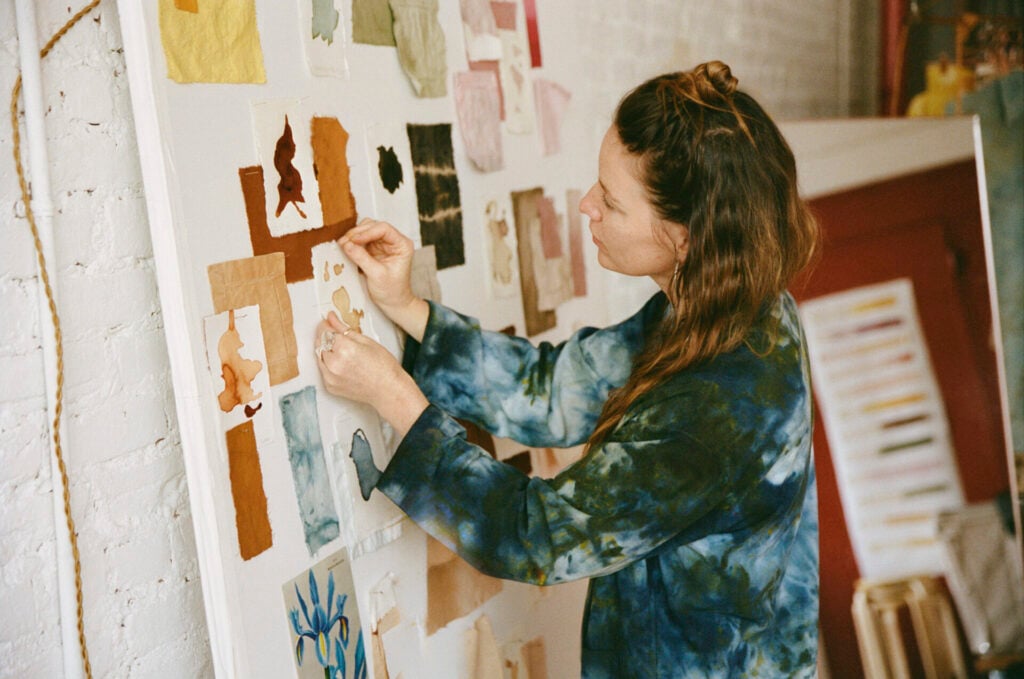
How does your background in set design influence your approach to creating textiles and glassware for Upstate?
A significant part of my work in set design involves curating scenes and understanding how all the elements and products can coexist harmoniously. Whether they are rooms, outdoor spaces, or more conceptual still life scenarios, it has helped me identify what is lacking, whether it’s a shape, color, or texture, and I feel inspired to bring that to life. The styling of the photoshoots is always such a gift, and it’s wonderful to see all our hard work come together!
Upstate has expanded to include glassware. What inspired this addition, and how does the glassware complement your textile work?
I was introduced to various glassware while working on photoshoots and became enamored by it! I wanted to incorporate another element into my practice outside of fabric that reflected my love for color, and I appreciate the juxtaposition between glass and fabric and the unexpected harmony it creates through softness and tension. I’ve always been fascinated by the way color attaches and flows through both fabric and glass; glassblowing achieves a similar effect despite being completely different. Additionally, I have a deep passion for cooking dinner for friends and setting the table, and the glassware felt like the perfect accessory to the linens I was creating.
Your glassware is hand-blown in Brooklyn. How do you collaborate with local artisans to bring your designs to life?
Yes, it’s made at Urban Glass in Brooklyn. In 2018, I took a six-week glassblowing class, thinking I could create these objects. Instead, I produced a very wonky marble and cup with the help of my teacher. By taking this class, I developed connections with artisans at Urban Glass who collaborated with me to bring my vision to life. When we are prototyping, I usually create a mood board with sketches, watercolors, and references. Every glass color behaves differently, so we often have to do many tests. We will sketch our ideas on the floor with chalk and have that as a working reference throughout the day.
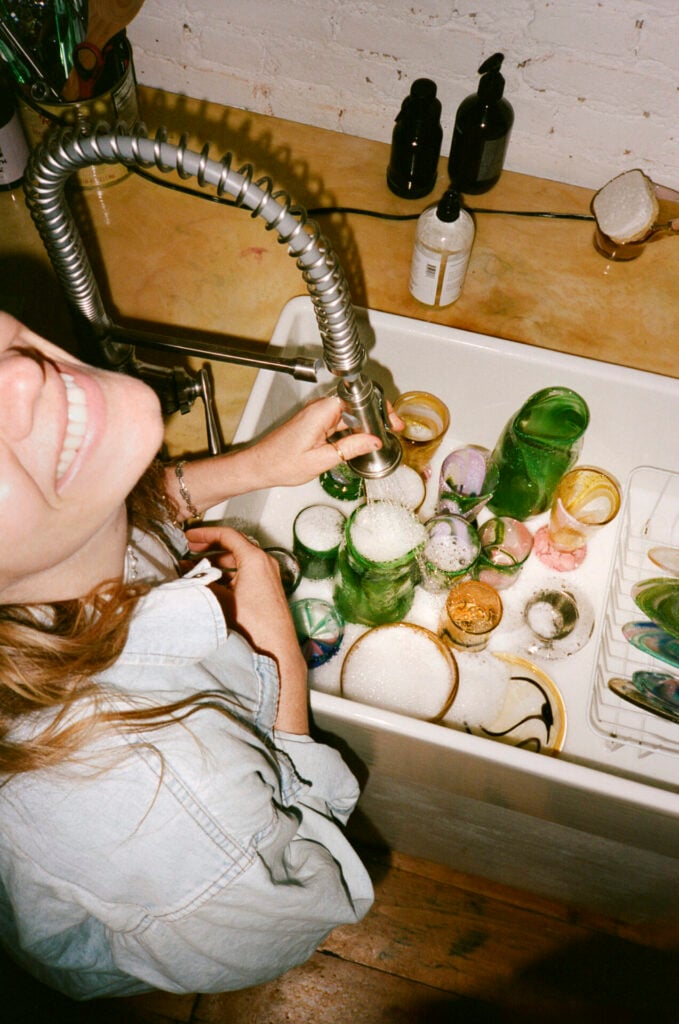

As someone who grew up in Boulder, Colorado, how has moving to NYC influenced your creative process and the evolution of Upstate?
I’ve been in NYC for almost 20 years, which is crazy! Naming the company Upstate back in 2010 referred to the idea of escape. When I first visited Upstate New York in 2008, I think I had one of the most fun weekends of my life. It felt remote and exotic yet was so close to the city. Naming Upstate, Upstate in 2010 alludes to the idea of escaping the everyday and you can do this while you’re making things (for me…dyeing). I’m very drawn to naturalist art and colors derived from nature, stemming from the endless hours I spent riding my horse in nature as a kid.
You often host workshops and events at your Chinatown studio. How do these gatherings contribute to your creative practice and the Upstate brand?
The workshops have been a nice, natural progression for the business. As much as I enjoy working alone in my studio, it can be isolating, and I appreciate community-driven events that don’t always involve my usual network of people. Opening them up to anyone who wants to join has pushed me out of my bubble and allowed me to meet all types of people. I think we are all craving in-person experiences where we put our phones away for a few hours to learn and create something that is both healing and rewarding. Additionally, given how quickly the world is moving with fast fashion, I believe it’s a great way to bring people’s attention back to reinvigorating their clothes and giving them new life and teaching them an easy way to bring this practice home with them.
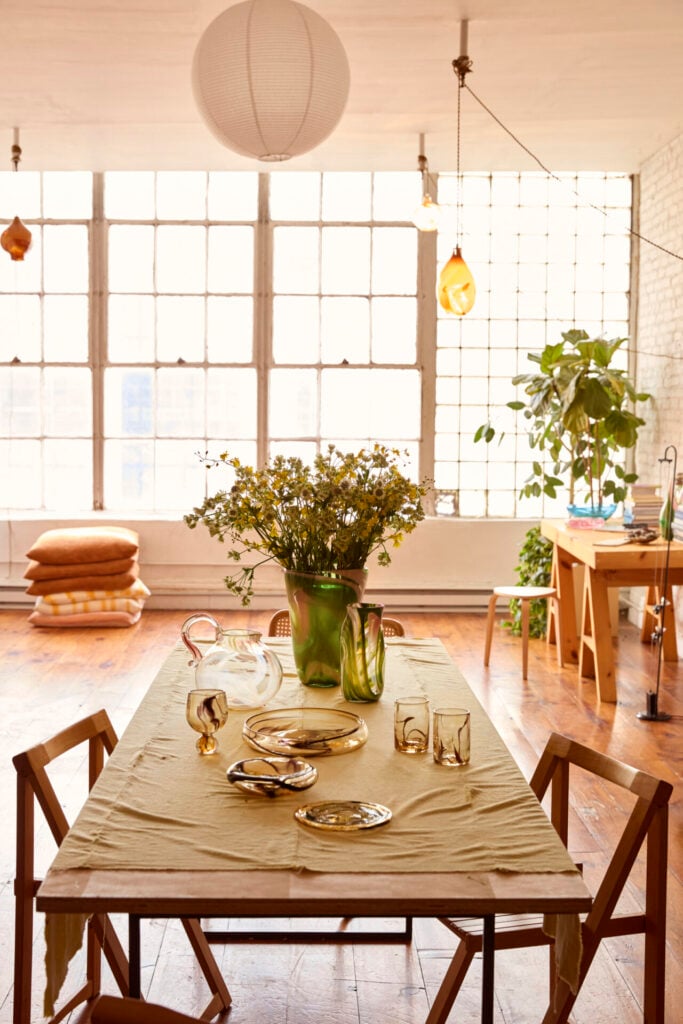
Can you tell us about a recent collaboration or workshop you’ve hosted that was particularly meaningful or inspiring?
I always love collaborating with my friend Lily Saporta Tagiuri; we have done a few events together. One event, we called color sessions, where we discussed the meaning of color to us, played with different colors through painting and dyeing with fabrics and paper, and then ended by making our own onigiri rice balls with edible dye food toppings. It was a very sensorial experience! Last summer, we also had a great evening discussing water at my studio, the effects of waterways in urban centers, and how we can clean them up. We created a fabric installation with fabric dyed to resemble a flowing river and a fountain. I love being around her stubborn optimism and vibrant creativity!
Your work is deeply inspired by nature. How do you maintain this connection while living and working in New York City?
I always say that one of the most essential parts of living in NYC is LEAVING NYC. I am so grateful that we have a little house in the Berkshires. If Im in the city one of the greatest luxuries for me is being able to wake up super early and take a morning beach moment before work or a walk around thompkins. Even bike riding in the city helps me disconnect from the grind and appreciate the cities natural elements. I have a dream of being part of a community garden in the East Village, where I can grow a variety of dyes, herbs, and flowers, and hold my meetings in the gardens over a coffee instead of via Zoom. Being in nature also allows me to be more analog, which I crave.
Upstate emphasizes sustainability in its practices. How do you balance environmental concerns with the demands of running a creative business in NYC?
I believe the term sustainability is often overused, and at the end of the day, it’s difficult to call my brand sustainable when I am still producing waste. That said, I make every effort to implement sustainable practices on a daily basis. A few years ago, we eliminated all plastic packaging and switched to recyclable or compostable packing materials. Even our tape is paper tape, which is biodegradable. Most of our packing materials are sourced from Eco-Enclose a company I recommend checking out. It took some time to figure out how to ship glassware without bubble wrap while ensuring it wouldn’t break and we figured out a system through working with eco-enclose. For dyes, we use either natural or fiber reactive dyes. Fiber reactive dyes are classified as low impact because they contain fewer chemicals than fully synthetic dyes and are free from heavy metals, AZO dyes, and chemical mordants. I started with only using fibre reactive dyes in 2010 and years ago, someone advised me to grow my business and outsource the dyeing to LA. I tried this, but those dye houses used toxic dyes, prompting me to bring the process back in-house so we could handle everything ourselves. I also realized the actual dyeing process was my favorite part of the business. Tracking the sustainable production of fabrics, especially silk, has proven to be challenging for me. While silk is my favorite fabric to work with, I would love to find a more local alternative. Companies like Spiritex are excellent because they are very transparent about how and where their cotton is grown and woven. Regarding scraps, I try to incorporate them into other projects or donate them to friends’ projects. And workshops, those have been great because it’s all about reworking what you already have!
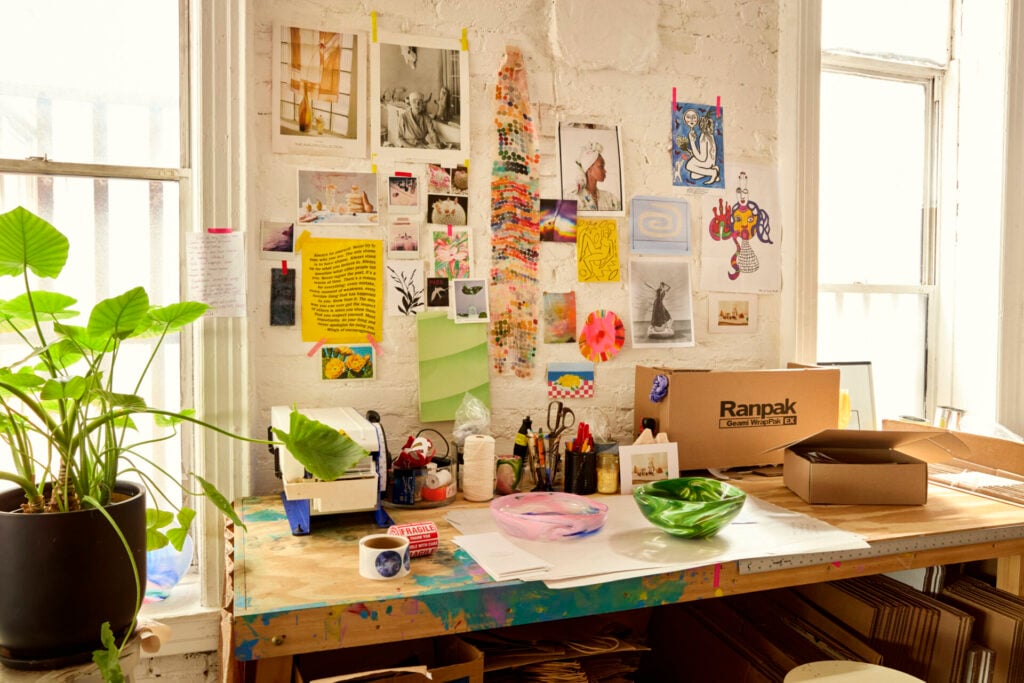
Your recent workshop, “The Art of the Altar,” combined dyeing with creating sacred spaces. How do you see the intersection of craft and spirituality in your work?
To me, creativity and spirituality inspire one another and go hand in hand. Exploring these realms, whether through meditation, chanting, journaling, or movement, it all helps with my creative flow. In 2018, I trained in Transcendental Meditation at the David Lynch Foundation and have been doing my best to practice for 20 minutes twice a day. On weekdays, it’s typically hard to fit in a second meditation, but when I do, it’s amazing! For Art of the Altar, I joined forces with my incredibly talented friend Heidi Smith of Moon and Bloom. Heidi is an herbalist, therapist, and flower essence practitioner, and she just released her second book called The Uncommon Book of Prayer. It’s all about deepening your spiritual practice to discover more joy, personal growth, and societal change. Heidi and I led an afternoon of meditation, discussing the significance of having an altar in your space, and dyeing altar cloths with seasonal plants.
As Upstate has grown from a passion project to a full-fledged creative studio, how have you adapted your role and creative process?
I’ve had to become much more structured with my schedule to balance all of the meetings, production, and deadlines and become very organized with my delegating. However, this also means ensuring I set aside blocks of time for experimentation and play. I also need days completely alone in the studio, as well as other days with my assistants to work through things. Because we are still small, we can pivot when something isn’t working, which I believe is essential for a small business. When I’m at my house in the country, I’ve adopted a painting practice. It’s funny because I only have the urge to paint there, and nobody besides my boyfriend has seen the work- or probably ever will. Yet, it’s a time when I can be creative and step away from anything work-related and do something just for me.
Your designs often draw inspiration from your travels. Can you share a recent travel experience that has influenced your work with natural dyes or glassware?
For the past few years, I’ve been visiting the Aeolian Islands and always return deeply inspired by the colors. It is a wild island with the clearest, bluest water, rocks in deep rusts,, charcoals and, tobaccos, and a mix of white, beige, tan, blush, and green plants and grasses… as the hot summer begins to dry things out. I’m always sending my glassblower photos of the colorful rock formations or pictures of cloud patterns, wanting to recreate them. For clothing, I usually come back inspired to create something I want to wear all day, every day on vacation.
Dreamscapes and Visions: If you were to imagine a dream project or collaboration, what would it look like? How would it reflect your current inspirations and creative aspirations?
I’m glad you asked this because I’ve been thinking about it so much. I would love to work on a community space like a restaurant, bar, venue of sorts and collaborate with the company and interior designer to develop items such as textiles, glassware, upholstery, and uniforms- something similar to Sessions Arts Club in London. I also dream of creating more installations and interactive events that bridge the gap between my set design career and Upstate. I want to design and make curtains for the NYC Ballet… Clothes for a dance performance. And one day, once I figure out my green thumb, I hope to cultivate a wild dye garden in the vein of Piet Oudolf. There’s so much…
If you were a color, what would you be? GREEN
Last song on your playlist. Sticky by FKA TWIGS
What is next for you and Upstate? I want to be more spontaneous and wild with my projects, not create what I think I should be making just so it will sell. I want to explore other natural mediums… thinking about seaweed resins etc… I love collaborating with brands and companies to bring their visions to life.
